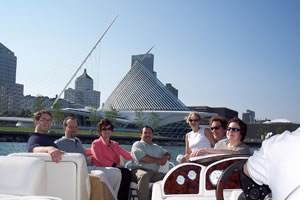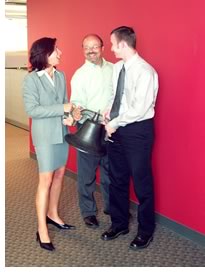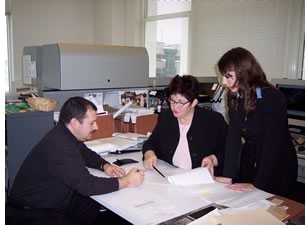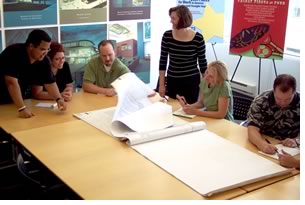

08/2005
Kahler Slater was named one of the top 10 small-business best places to work in the June 2005 HR Magazine and ranked 12th on that list in 2004. Run by the Great Place to Work Institute, the group that compiles the 100 Best Companies list every year for Fortune magazine, the Best Places to Work list is an annual compilation of innovative and inspirational management strategies for firms of all types, categorized by size. (A small firm is defined as companies employing between 50 and 250 employees.) Here is the how and why behind that singular honor for an architecture firm from an interview with the firm’s HR principal, John G. Horky, AIA.
Your Web site says “We are a close knit group who work hard and play hard.” How did you develop that culture?
When I joined Kahler Slater in 1991, we were about 35 people. We subsequently went through some pretty significant growth in the early ’90s, growing to 60 or so. Though we were growing, we didn’t really have a collective sense of vision of where we were going. We could have continued to be a very well regarded regional firm that has an excellent service reputation with clients. But we really wanted to understand the possibilities beyond that.
 We
spent about a year and a half engaged in introspective analysis as well
as benchmarking and getting a lot of information from clients, consultants,
and contractors telling us what they thought we are good at and what
differentiates us. We pulled all that together and, in 1996, unveiled
a new vision for the firm. One of the underpinnings for that reorganization
was to ask our people what they are passionate about, because we believe
that if anyone is doing something that they are really passionate about,
they are going to be happier, which translates into better service and
more satisfied clients. The thinking is that a client who finds that
working with us is a special experience will be more inclined to continue
working with us and refer us to their valued friends and peers. So, philosophically,
we organized the firm around market-focus team and assigned individuals
to them according to their own interests. The result is that people enjoy
their work and that comes through in service to the client.
We
spent about a year and a half engaged in introspective analysis as well
as benchmarking and getting a lot of information from clients, consultants,
and contractors telling us what they thought we are good at and what
differentiates us. We pulled all that together and, in 1996, unveiled
a new vision for the firm. One of the underpinnings for that reorganization
was to ask our people what they are passionate about, because we believe
that if anyone is doing something that they are really passionate about,
they are going to be happier, which translates into better service and
more satisfied clients. The thinking is that a client who finds that
working with us is a special experience will be more inclined to continue
working with us and refer us to their valued friends and peers. So, philosophically,
we organized the firm around market-focus team and assigned individuals
to them according to their own interests. The result is that people enjoy
their work and that comes through in service to the client.
The strongest indication that this approach has been working is that the generally held benchmarking statistic for repeat client work is about 70 percent of revenues. With us, it exceeds 90 percent.
Using yourself as an example, how does an architect morph into an HR principal?
I have been in architectural practice for more than 20 years and started with this firm as an architect in the years just before its rapid growth. We currently have 135 people and have grown 30 percent since the beginning of this year. When we had gotten to be about 100 people, the owners determined to invest in somebody dedicated to human resources leadership. There were two basic choices: find a pedigreed HR person who may or may not be familiar with the profession, and certainly would not have been familiar with the Kahler Slater culture. Or, look internally at somebody already familiar with the profession and the firm who could learn about HR. They approached me, going the latter route, which has worked out very, very well for the last seven years.
The significant advantage, I believe, is that I know, for example, what it means to be an architecture intern and sit for the registration exam. I can therefore be empathetic and provide our interns with the needed resources. Similarly, when we’re recruiting, I know the language and can establish rapport with the highest levels of talented people. Being an architect and a principal in the firm establishes credibility.
I got my HR training from the “HR Club.” Our consulting accountant at the time had, in turn, brought on board an HR consultant who was establishing herself in this marketplace. She offered a program she initially called the HR Club. For nine months, a group of about 15 of us from different small to midsize companies—one or two individuals from each—went over a specific topic. The first month was the Fair Labor Standards Act, then family medical leave, and best practices in doing performance reviews, and so on, taking that month’s topic and going over the legal issues and best practices. I coupled that with many of the offerings from local law firms, many of which offer training through legal breakfasts, and I participated in the local Society for Human Resource Management chapter. Networking and asking lots of questions of good legal counsel is also invaluable.
I did start with a propensity for business management. After my undergraduate degree in architecture at the University of Notre Dame, I pursued a master’s in business administration. The MBA classes that were most interesting to me were in organizational development because they reinforced on a formal level what I understood on an intuitive and personal level. When you’re working with people, there are choices. And, although it would probably be easier to manage a firm in a hierarchical, top-down scheme, where you’re the person at the top and everything you say goes. We go with the much more complex proposition of truly working collaboratively. It pays off in the long run.
 How do the firm principals instill collaboration into your firm culture?
How do the firm principals instill collaboration into your firm culture?
We live it from the top down. Instead of a single CEO, we have our 3EOs. This is a fourth-generation firm, begun in 1908. And the most recent generation of top-line leadership was established in 2001. The two namesakes are David Kahler, FAIA, and Mack Slater, AIA. After putting the firm on a track to continue to grow, Mack retired his shares in 1996, and David in 2001. The three vice presidents at that time stepped forward together: James Rasche, AIA; Jill Morin; and George Meyer, AIA. They decided that no one of the three really needed to be CEO and, likewise, none wanted to give up time with clients. So they came up with a triad model of sharing their firm-management responsibilities. And they work in open offices, along with everyone else.
Organizationally, we’re the antithesis of being departmentalized around specific phases or tasks. We are structured around client market types. We have, for example, a health-care team that has about 50 people and pursues a multitude of projects within that market. And that team comprises the full complement of interior designers, architectural designers, project managers, interns, team leaders, and the administrative professionals who support them. People do move around from project to project, but they’re all working collaboratively together.
Everyone in the firm is evaluated on the basis of the goals they have set. And the firm is committed to providing the means for achieving those goals. For instance, we average more than $1,600 per person in continuing education each year, with use of the funds determined on a team-by-team basis.
Goal-setting takes place during performance reviews, which we disassociate altogether from the compensation review. We have one formal goal-setting exercise per year for everybody in the firm, which takes place over a two-month period and involves goal setting as well as looking back to what had been accomplished. Six months later, we request everyone to get together with their reviewer again; not to document anything per se, but simply to check on progress and identify anything that might be getting in the way. And, of course, this is all within the context of the encouragement of day-to-day collaborative interaction. It is the duty of team leaders to share our thoughts on performance improvement in the moment and not wait six months.
By working in teams, we avoid the studio mentality where each department becomes an internal profit center because that tends to create internal competition rather than collaboration. We operate under the philosophy that what is good for the firm is good for all of us.
Do you have a process for team development?
Each team puts together a business plan every year. And, during that process, we encourage individuals or small groups of individuals to come forward with new business ideas. We call the process “entrepreneurship.” And we aggregate those team plans into a firm budget, which includes line-item commitments to professional development funding. If a team member sees a professional-development opportunity, he or she brings it up with the team leader, who gives approvals consistent with the set goals.
 How
does the firm develop collective knowledge?
How
does the firm develop collective knowledge?
We feel a key to our success is that we work hard to keep everyone in the company informed and engaged in the firm. Each team has weekly meetings. We have monthly all-staff meetings. And we have an annual all-staff retreat where we get away from the offices for the day. Each one of these structured activities has a different purpose.
The team meetings are for catching each other up with what we are doing—what we have just accomplished and what deadlines are coming up—to make certain that individuals within the team are all on the same page and point up any learning opportunities. For instance, if somebody working on one project within the health-care team has come up with an interesting solution that they want to share with the rest of the team, the weekly meeting provides that opportunity.
At the monthly staff meetings, we do a lot of cross-team celebration of success and sharing of stories and images of projects under development. We have a ship’s bell in the Milwaukee office that we ring anytime a team wants the office to know there is an achievement to celebrate. The monthly meetings are an opportunity to go into more depth about what the team did. (There is some lighthearted rivalry with the Madison office. After winning a particularly large commission, they purloined the ship’s bell and took it back to Madison to ring it there. The Milwaukee office snatched it back again later.) At the monthly meeting we also introduce any new people and, when somebody has come back to the firm, we have the “sacred boomerang ceremony.”
The annual all-staff retreat is an opportunity to focus our collective attention on a particular topic of pertinence for that year. Our 3EOs also offer a “state of the firm” address where they have been known to dress in costume to fit whatever the particular retreat theme is for that year. Last year, they were dressed as historic ship captains in full regalia.
Another information-sharing activity involves our most senior project architects—we call them our sages. They get together on a semi-regular basis and ruminate about how our processes are working, any areas for improvement, and whether there are issues developing out there that everyone should know about.
Our turnover is very low, about 4 percent. So another business might look at us and say we spend a lot of money on recruiting and retention. My counter is that we aren’t spending money on replacing people. Making Kahler Slater a great place to work is a proactive investment, which is very different from the reactive mindset of getting a warm body in a chair to get a project done. On many different levels, we try to create a collaborative work environment. And, organizationally, one benefit is depth of talent.
How did you get the idea to submit Kahler Slater for the Best Places to Work list?
The equivalent to the AIA is the Society for Human Resource Management. They unveiled the Best Places to Work program at their 2003 national convention. I saw that as a blurb on the Web site and said, “Well, I know what we’re about; what we had been striving to do to become, by our own definition a best place to work.” And, as a natural opportunity, I nominated our firm that same day online.
 A few words from KS employees
A few words from KS employees
To get a sense of what Kahler Slater
staff like about the firm, AIArchitect also
talked to a principal, design associate, and intern. Here are their vignettes.
Jennifer Schlimgen, AIA, principal, health-care-facility team:
I’m now on a four-month sabbatical, basically to catch up on personal
commitments and recharge my batteries. It isn’t spelled out as
a part of the benefits package, but it is very nice to work in a firm
that sees the benefit of allowing this kind of schedule flexibility.
It’s true that part of the process at Kahler Slater is to decide
what your design passion is, and there is no doubt that my passion is
for health care, working to create facilities that support patients and
their families as well as the health-care providers.
Matt Rinka, AIA, design associate, health-care-facility
team:
I’ve
worked very closely with Jennifer for the last two years, for instance
on St. Mary’s Hospital in Madison—about a $200 million expansion,
which is typical of our health-care projects. Jennifer holds a very close
relationship with the clients. The beauty is that several people, like
myself and the project architect, share the relationship with the client,
so if a key person takes a sabbatical, it doesn’t kill the relationship
with the client. It really reinforces the collaborative nature of the
firm and our process of design, which, I would say, is the most differentiating
thing about this firm.
Kyle Miller, architecture intern, higher
education team:
I think that
coming out of undergraduate school, you’re looking for something
that will really provide you with a diverse set of experiences. That
is what I’ve found in my year here. I am preparing to go to graduate
school at UCLA next month, and my experience here has been invaluable.
And it’s gratifying that friends from architecture school recognize
Kahler Slater as the firm that worked with Santiago Calatrava on the
Milwaukee Art Center.
Copyright 2005 The American Institute of Architects.
All rights reserved. Home Page ![]()
![]()
 |
||
For
more information on Kahler Slater, visit their Web site. For more information on entering the Best Place to Work competition
for 2006, visit the Great Place to Work Institute Web site.
|
||